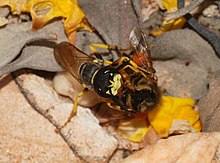| European beewolf | |
|---|---|

| |
| A European beewolf | |

| |
| European beewolf paralysing a bee | |
| Scientific classification | |
| Domain: | Eukaryota |
| Kingdom: | Animalia |
| Phylum: | Arthropoda |
| Class: | Insecta |
| Order: | Hymenoptera |
| Family: | Philanthidae |
| Genus: | Philanthus |
| Species: | P. triangulum
|
| Binomial name | |
| Philanthus triangulum (Fabricius, 1775)
| |
| Synonyms[1] | |
| |
The European beewolf (Philanthus triangulum), also known as the bee-killer wasp or the bee-eating philanthus (from the now obsolete synonym Philanthus apivorus), is a solitary wasp that lives in the Western Palearctic and Afrotropics. Although the adults of the species are herbivores (feeding on nectar and pollen), the species derives its name from the behaviour of the inseminated females, who hunt Western honey bees. The female places several of its paralysed prey together with an egg in a small underground chamber, to serve as food for the wasp larvae. All members of the genus Philanthus hunt various species of bees, but P. triangulum is apparently the only one that specialises in Western honey bees.
- ^ "Synonyms for "Philanthus triangulum"". GBIF.org. Retrieved 20 May 2017.